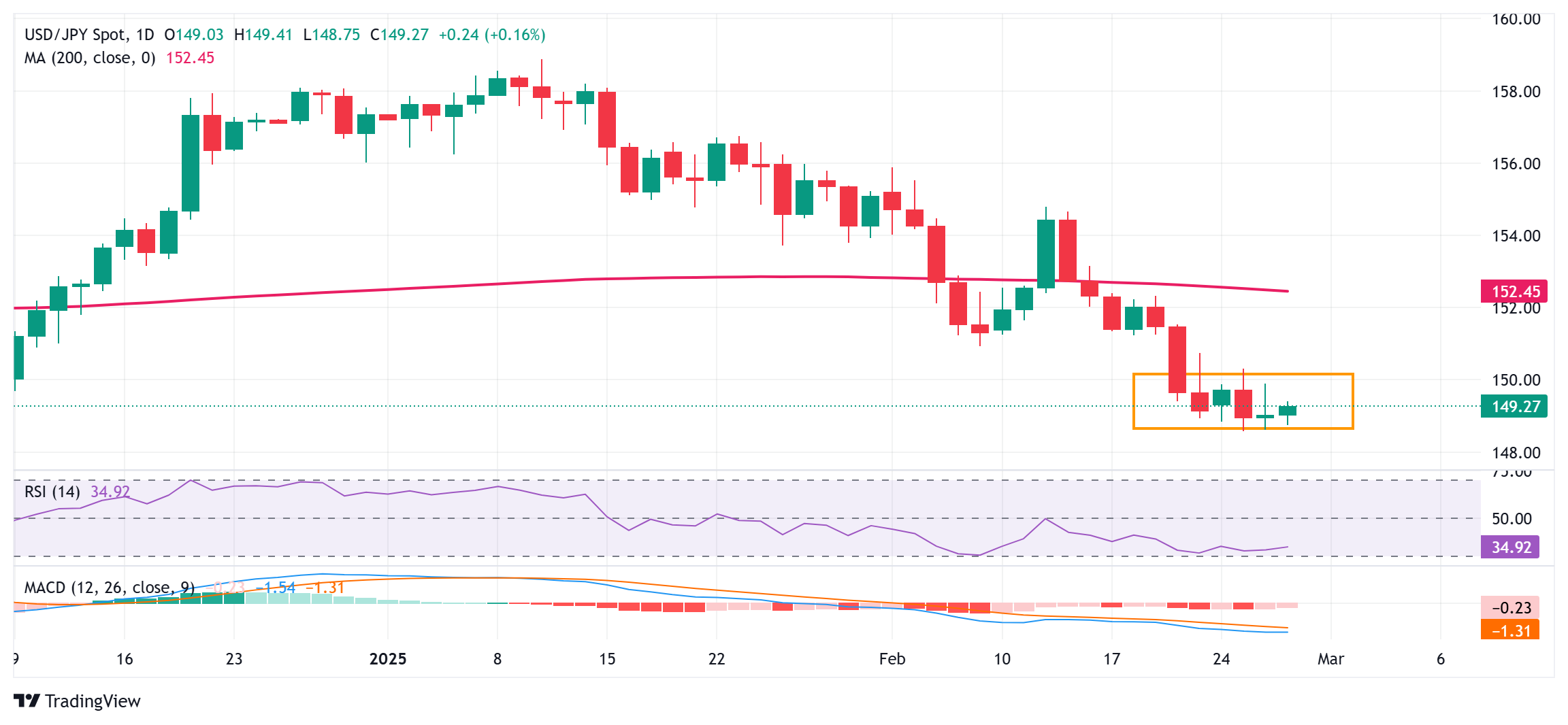Japanese Yen weakens amid sliding JGB yields; USD/JPY moves closer to mid-149.00s
- The Japanese Yen attracts some sellers amid the recent sharp pullback in JGB yields.
- Bets that the BoJ will hike interest rates further should help limit losses for the JPY.
- Expectations for more Fed rate cuts might cap the upside for the USD and USD/JPY.
The Japanese Yen (JPY) is ticking lower against its American counterpart during the Asian session on Thursday, though it remains close to the highest level since October 2024 touched earlier this week. Bank of Japan (BoJ) Governor Kazuo Ueda's comments last week about potentially increasing regular bond buying led to a further decline in the Japanese government (JGB) bond yields. Apart from this, concerns over US President Donald Trump's tariff plans and a positive risk tone turn out to be key factors undermining the JPY.
Any meaningful JPY depreciation, however, still seems elusive in the wake of the growing market acceptance that the BoJ will continue raising interest rates this year amid broadening inflation in Japan. In contrast, expectations that a cooling US economy would give the Federal Reserve (Fed) more impetus to cut interest rates keep the US Dollar (USD) bulls on the sidelines and cap the USD/JPY pair. Traders also seem reluctant ahead of the release of the US Personal Consumption Expenditure (PCE) Price Index on Friday.
Japanese Yen is pressured by declining JGB yields; downside seems limited amid BoJ rate hike bets
- Bank of Japan Governor Kazuo Ueda said last week the central bank was ready to increase government bond buying if long-term interest rates rise sharply, dragging Japanese government bond yields away from a more-than-a-decade high.
- In fact, the yield on the benchmark 10-year JGB touched its lowest level since February 12 and undermined the Japanese Yen, pushing the USD/JPY pair back closer to mid-149.00s during the Asian session on Thursday.
- Japan’s inflation accelerated at the fastest pace since the summer of 2023 in January and keeps the Bank of Japan on track to raise its benchmark interest rate further, which might hold back traders from placing aggressive JPY bearish bets.
- US President Donald Trump ordered an investigation on copper imports to assess whether tariffs should be imposed due to national security concerns. Trump also confirmed that tariffs on Canada and Mexico are "on time and on schedule".
- Trump has already raised tariffs on goods from China and threatened new reciprocal tariffs for each country. Furthermore, Trump said on Wednesday that his administration will soon announce a 25% tariff on imports from the European Union.
- Bets for more interest rate cuts by the Federal Reserve are on the rise amid the recent downbeat US macro data, which pointed to a cooling economy and fueled worries about the growth outlook. This keeps the US Dollar bulls on the defensive.
- Atlanta Fed President Raphael Bostic said on Wednesday that inflation has seen a lot of progress, though is still high and the US central bank should hold rates where they are, at a level that continues to put downward pressure on inflation.
- Investors now look forward to a slew of key economic reports from Japan, due on Friday, including Industrial Production, Retail Sales, and Tokyo inflation, which could provide further clarity on the BoJ's monetary policy outlook.
- Friday's economic docket also features the release of the US Personal Consumption Expenditure (PCE) Price Index – the Fed's preferred inflation gauge. This would influence the USD and provide a fresh impetus to the USD/JPY pair.
USD/JPY could attract fresh sellers near the overnight swing high and remain capped near 150.00

From a technical perspective, the USD/JPY pair has been oscillating in a familiar range since the beginning of this week. This comes on top of the recent downfall from the year-to-date high touched in January and might still be categorized as a bearish consolidation phase. Moreover, oscillators on the daily chart are holding deep in negative territory and are still away from being in the oversold zone, suggesting that the path of least resistance for spot prices remains to the downside.
Hence, any further move up could be seen as a selling opportunity near the 149.75-149.80 region and remain capped near the 150.00 psychological mark. A sustained strength beyond the latter, however, could trigger a short-covering rally and lift the USD/JPY pair further towards the 150.90-151.00 horizontal support breakpoint, now turned strong barrier.
On the flip side, the 149.00 round figure now seems to protect the immediate downside ahead of the 148.60 region, or the multi-month low. Some follow-through selling will be seen as a fresh trigger for bearish traders and drag the USD/JPY pair to the 148.00 mark en route to the next relevant support near the 147.35-147.30 area and the 147.00 round figure.
Japanese Yen FAQs
The Japanese Yen (JPY) is one of the world’s most traded currencies. Its value is broadly determined by the performance of the Japanese economy, but more specifically by the Bank of Japan’s policy, the differential between Japanese and US bond yields, or risk sentiment among traders, among other factors.
One of the Bank of Japan’s mandates is currency control, so its moves are key for the Yen. The BoJ has directly intervened in currency markets sometimes, generally to lower the value of the Yen, although it refrains from doing it often due to political concerns of its main trading partners. The BoJ ultra-loose monetary policy between 2013 and 2024 caused the Yen to depreciate against its main currency peers due to an increasing policy divergence between the Bank of Japan and other main central banks. More recently, the gradually unwinding of this ultra-loose policy has given some support to the Yen.
Over the last decade, the BoJ’s stance of sticking to ultra-loose monetary policy has led to a widening policy divergence with other central banks, particularly with the US Federal Reserve. This supported a widening of the differential between the 10-year US and Japanese bonds, which favored the US Dollar against the Japanese Yen. The BoJ decision in 2024 to gradually abandon the ultra-loose policy, coupled with interest-rate cuts in other major central banks, is narrowing this differential.
The Japanese Yen is often seen as a safe-haven investment. This means that in times of market stress, investors are more likely to put their money in the Japanese currency due to its supposed reliability and stability. Turbulent times are likely to strengthen the Yen’s value against other currencies seen as more risky to invest in.

